
Johann Jakob - Drage from "Oresiphoites Helveticus, 1723.

Above is an engraving by Michel Nicolas Micheux.
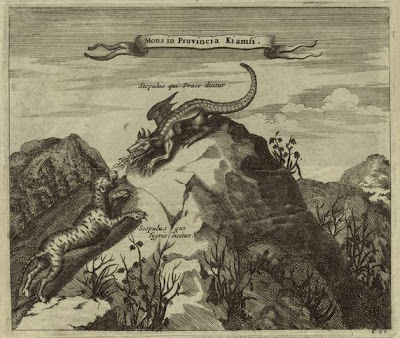
The above is an interpretation of a Chinese dragon by the artist Athansius Kircher from 1667.

The above print is by Jacob Grimm from 1912.
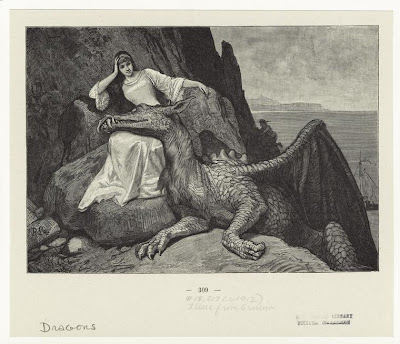
And another print by Jacob Grimm from 1912.

One more work by Jacob Grimm, print dated 1912.

A cropping from an engraving by the Italian Bernardo Daddi titled "Apollo Killing The Python, from the series The Story of Apollo and Daphne." 16th century
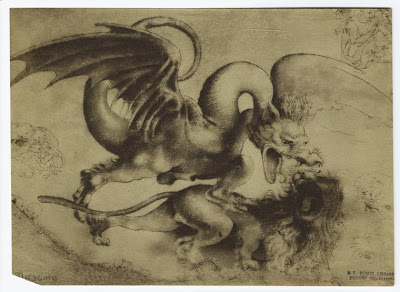
The above drawing was made by Leonardo da Vinci.

Albrecht Dürer - The Apocalyptic Woman, St John Devouring the Book, eleventh plate from the series The Apocalypse, 1498 woodcut.
Here is text concerning this interpretation of the dragon...
"THE constellation Draco, the Great Serpent, was at one time ruler of the night, being formerly at the very centre of the heavens and so large that it was called the Great Dragon. Its body spread over seven signs of the Zodiac, which were called its seven heads. So great a space did it occupy, that, in mystic language, it "drew a third part of the stars from heaven and cast them to the earth." Thuban, in its tail, was formerly the pole-star, or "judge of the earth!' It approached much nearer the true pole than Cynosura, the present pole-star, which is one and a half degrees distant and will never approach nearer than twelve minutes, while Thuban was only ten minutes distant.
At an early day serpents were much respected; they were thought to have more "pneuma" or spirit than any other living thing and were termed "fiery." For this cause high initiates were called "naga," or serpents of wisdom; and a living serpent was always carried in the celebration of the mysteries. During the brilliant eighteenth and nineteenth Egyptian dynasties, Draco was a great god; but when this constellation lost its place in the heavens, and Thuban ceased to be the guiding sidereal Divinity, it shared the fate of all the fallen gods. "The gods of our fathers are our devils," says an Arabic proverb. When Re-Veilings was written, Draco had become a fallen angel representing evil spirituality. By precessional motion the foot of Hercules rests upon its head, and we find it depicted as of the most material color, red." - read more here.
The Great Red Dragon or Satan as described in the Book of Revelations can be seen in the following watercolor paintings created between 1805-1810 by William Blake.

"The Great Red Dragon and the Woman Clothed with the Sun"

"The Great Red Dragon and the Woman Clothed in Sun"
View more of the Red Dragon series here.

And one more dragon related work by Blake, The above engraving is from 1795 and titled Tornado, "added to the third edition of The Botanic Garden by Erasmus Darwin."

Raphael Sanzio - St Michael and the Dragon, oil on wood 1505. It's interesting to see the influence of Hieronymus Bosch in the work of Raphael, if only he'd made more paintings like this! Here is the religious text the above painting is based upon...
"In the Epistle of Jude of the New Testament in verse 9, Michael disputes with Satan over the body of Moses. In Revelation 12:7-8, "And there was a great battle in heaven, Michael and his angels fought with the dragon, and the dragon and his angels fought back. But he was not strong enough, and they lost their place in heaven." John describes Satan being thrown out of heaven three and a half years from the end of the age, "a time, times and half a time" Revelation 12:14. Satan being thrown from heaven coincides with the "abomination that causes desolation" as spoken of by the prophet (Daniel 9:27)."

The above is a wood engraving by Gustave Doré, a frontpiece from the book "Les Aventures du Chevalier Jaufre et de la belle Brunissende" dated 1856.
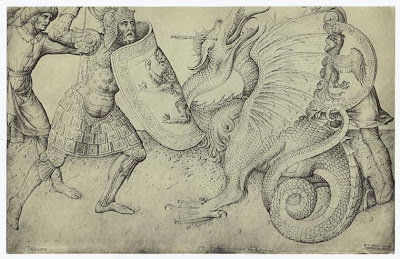
Jacopo Bellini - A warrior fighting a dragon, print from 15th century.
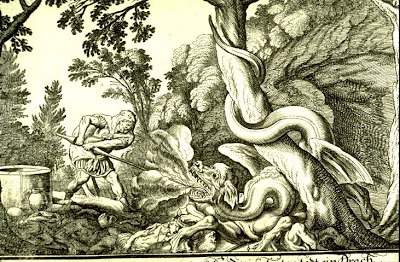
Cadmus and the Serpent, from Book 3 of Ovid's Metamorphses. View more woodcuts and engravings from this book here.
An image of Perseus freeing Andromeda attributed to Moritze Meurer. Image found thanks to Peacay Chez.
Tomorrow will be devoted to the many artworks surrounding the knight and the dragon.

No comments:
Post a Comment